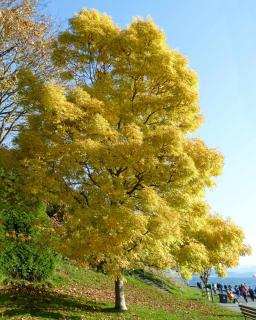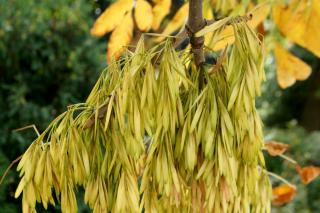

Apart from its very hard wood and its elegant ornamental appeal, the ash tree has long been used for its health benefits and therapeutic properties.
Key facts about the Ash tree
Name – Fraxinus excelsior
Family – Oleaceae
Type – tree
Height – 32 to 100 feet (10 to 30 meters)
Exposure – full sun
Soil – rich, rather chalky
Foliage – deciduous
Flowering – March to May (after 30 years of age)
The Ash tree is planted in fall in ordinary soil, either enriched or naturally so.
It’s important to plant your ash tree in a luminous spot of the garden, away from other trees.
Since it grows tall, try to keep a strict minimum of at least 20 feet (6 m) from house walls. Having 30 feet (10 m) or more is best to avoid issues later on.
When propagating through seed, autumn is the best season because the winter colds would slow its growth. September and October are thus the best months to plant your ash tree in a large nursery pot.
If you live in a very windy spot, placing a stake in the ground to keep the plant upright will keep it from toppling over and is strongly recommended.
Once the cold season is over, you may transplant the seedling to the ground in spring.
The ash tree won’t require any care, and doesn’t also need any pruning. If you feel your soil is very poor, you can help it with a very small dose of fertilizer (phosphorus and potassium) during the first few months. The growth phase of this tree is in spring (before the blooming). The blooming lasts from March to May.
At the beginning of spring, remember to remove undesirable buds from the trunk. When you observe that a branch is growing well, it’s recommended to pinch or snip off the tip of the branch to stop its growth.
Psyllids (which are sap-suckers) look like small grasshoppers and often spread diseases. They can harm a tree quite a lot. Overall, though, ash is a very resilient tree.
The pruning, if needed, should be performed in October.
As regards the harvest, it’s recommended to collect young ash tree leaves when they secrete a gummy, sticky substance. That’s when the health benefits of ash are at their highest.
The most adequate time frame for this is between May and June. However, to harvest some bark, best act in fall. Once you’ve collected your bark or leaves, dry them in a dry and ventilated spot.
Ash is a flower tree that grows up to 100 feet (30 meters) and even 130 feet (40 meters). Its flowers are red and the leafage is deciduous.
 As mentioned above, there are over sixty ash tree species around the planet.
As mentioned above, there are over sixty ash tree species around the planet.
However, the most common varieties are, among others:
– red ash or “Fraxinus pennsylvanica” that grows in open spaces,
– white ash or “Fraxinus americana” that, conversely, grows best in forests,
– Fraxinus angustifolia has narrow leaves,
– and, last but not least, black ash (very famous in Canada) which grows very well in cold marshes, along riversides or in oft-swamped forests.
 Ash is a tree that grows quite fast, and, in time, the trunk can grow to a width of over 3 feet (1 meter).
Ash is a tree that grows quite fast, and, in time, the trunk can grow to a width of over 3 feet (1 meter).
Leafage is a bit particular in that it appears quite late, around the month of May, but it will stay on the tree until the very end of autumn.
Ash is known for the many health benefits it procures the body.
Incidentally, it is among one of the best possible firewoods, since it’s dense and hard.
The ash tree is hardy and will grow in almost any kind of environment!
Once you’ve transplanted your seedlings to the ground, watch how fast your ash tree will grow: it will near adult size within 5 years!
We lost our Ash trees in the great freeze in Texas a couple of years ago. We cut them down, but one tree that was near our patio was sprouting suckers. We did not get around to treating them and now we have a beautiful “bush”. Can we trim it and keep it as a bush?
Why, yes of course! You’ll have to do quite a lot of trimming, though, because that little bush has the vigorous root system of an entire tree!
If you’re into vegetable gardening, those shoots will grow into long, straight poles that you can harvest with loppers when they’re an inch or two across. Done regularly, it’s called coppicing. Excellent for pole beans! Though near your patio, a short bushy ash might be more elegant.
can i transplant my 20 year old green ash tree in the summer
HOW MUCH SPACE DO THESE ASH TREES NEED FROM THE BRICK WALL TO THE HOUSE?
Hello Glenda! These can grow quite tall, so an absolute minimum of 20 feet (6-7 meters) should be kept. Ideally, having 30 feet (10 m) between trunk and the closest wall would be best. That way, the tree can grow at ease and develop very nicely, without causing any problems whatsoever to the house and its foundations.
thanks for the informative article!
An Ash tree has started growing close to my rental house and I was going to move it to a new area at the end of winter, however, I kind of want to keep it forever if possible? Could it live in a pot for a year? Or is this absurd?
Hello Elle! It’s perfectly possible for a tree to live in pots for a while, especially if you’re fond of it and want to bring it somewhere new.
It’s mostly a question of how practical it is, which depends on size and how much you effort you’re ready to sacrifice for that! Entire trees can be moved with cranes and the like.
Seedlings and saplings under two feet tall can stay for a year in pots about 8 to 10 inches (20 to 25 cm) across. Trees two to four feet tall will do great in a pot one to one and a half feet tall (30 to 45 cm). Saplings four to 7 feet tall can survive for a year in a pot at least two feet across (60 cm). Depth of the pot should match the size across.
Try to go about carefully without twisting or breaking the trunk, and follow my tips on avoiding transplant shock and your little ash tree will be fine!
If you keep you ash tree in a pot for too long, that’s also ok but it’ll start growing stunted, it may even go dwarvish like a bonsai might.